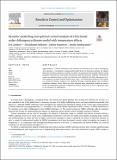| dc.contributor.author | Lusekelo, Eva | |
| dc.contributor.author | Helikumi, Mlyashimbi | |
| dc.contributor.author | Kuznetsov, Dmitry | |
| dc.contributor.author | Mushayabasa, Steady | |
| dc.date.accessioned | 2023-03-02T08:28:31Z | |
| dc.date.available | 2023-03-02T08:28:31Z | |
| dc.date.issued | 2023-01-19 | |
| dc.identifier.uri | https://doi.org/10.1016/j.rico.2023.100206 | |
| dc.identifier.uri | https://dspace.nm-aist.ac.tz/handle/20.500.12479/1818 | |
| dc.description | This research article published by Elsevier, 2023 | en_US |
| dc.description.abstract | Approximately 1.3 billion inhabitants in 94 countries are estimated to be at risk of chikungunya
virus infection. A mechanistic compartmental model based on fractional calculus, the Caputo
derivative has been proposed to evaluate the effects of temperature and multiple disease control
measures (larvicides use, insecticides and physical barriers) during an outbreak. The proposed
model was calibrated based on data from literature and validated with daily chikungunya fever
cases reported at Kadmat primary health centre, India. The transmission potential of the disease
was examined. Sensitive analyses were conducted through computing partial rank correlation
coefficients. Memory effects which are often neglected when mechanistic models are used to
model the transmission dynamics of infectious diseases, were found to have a significant effect
on the dynamics of chikungunya. | en_US |
| dc.language.iso | en | en_US |
| dc.publisher | Elsevier | en_US |
| dc.subject | Chikungunya fever | en_US |
| dc.subject | Mathematical model | en_US |
| dc.subject | Memory effects | en_US |
| dc.subject | Temperature | en_US |
| dc.subject | Control strategies | en_US |
| dc.title | Dynamic modelling and optimal control analysis of a fractional order chikungunya disease model with temperature effects | en_US |
| dc.type | Article | en_US |

